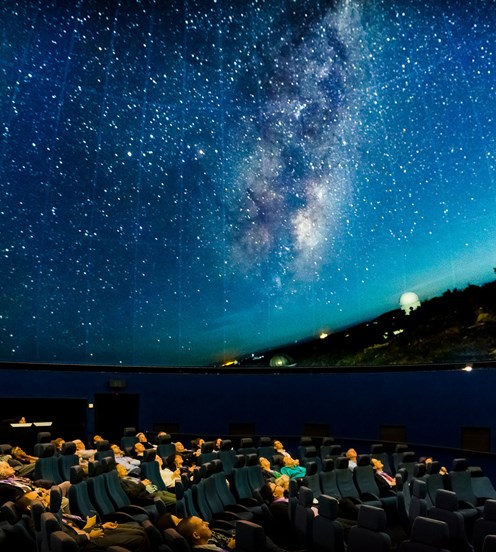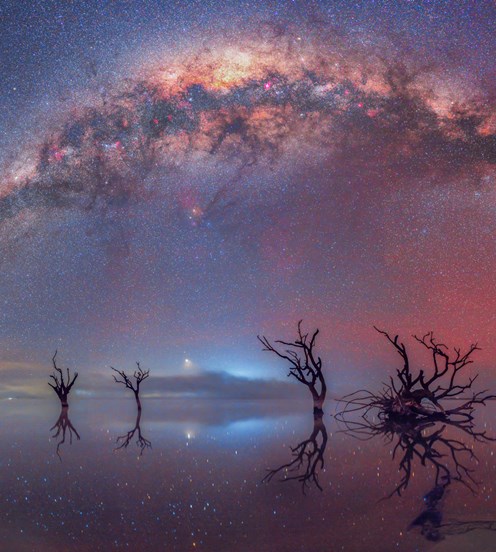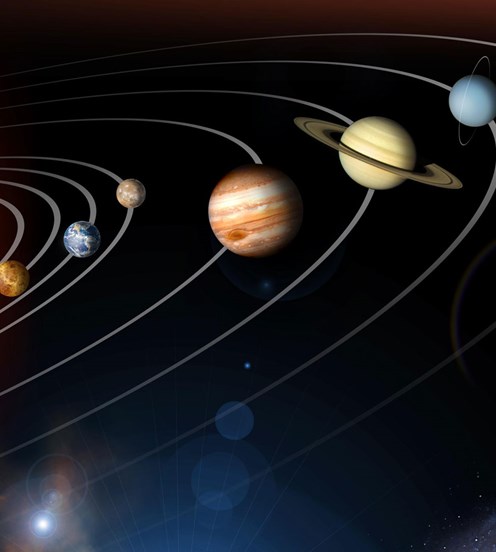
Melbourne Planetarium
The sky indoors - shows run every day under the dome exploring space, astronomy and the night sky.

The sky indoors - shows run every day under the dome exploring space, astronomy and the night sky.

Enjoy science and art on Friday nights in unique full-dome format.

Enjoy a gallery of glorious astronomy photos with admission to Scienceworks. Ends 18th April.

We're excited to bring you an online series exploring our Solar System. Over four sessions, we'll take you on a journey to all the planets and beyond.
All months in the year have their special dates, but arguably April is a very significant one in the history of astronomy and space exploration.
Several major anniversaries fall this month: the first photograph of the sun taken on 2nd April 1845, some 176 years ago; the publication of Albert Einstein’s Special Theory of Relativity on 11th April 1905; the 60th anniversary of the first human into space, Soviet Cosmonaut Yuri Gagarin on 12th April 1968; the 50th anniversary of the first space station, Soviet Salyut 1 on 19 April 1971; and the 40th anniversary of the launch of the first reusable spacecraft, the US Shuttle Columbia on 12 April 1981.
Choosing one as an example of how our understanding of the universe has grown aided by the development of a key technology, we look back 176 years to the first recorded image of the ultimate source of all life on Earth, and the origin of the entire solar system, our local star the sun, and compare it to one of the most recent images of its power and complexity.
This image, some 12 cm in diameter, is in the form of a daguerreotype (named after its inventor Louis Daguerre). A copper plate coated in silver-halide was made light-sensitive by halogen fumes and exposed for a few seconds to its enlarged objective - the sun. A mist of mercury vapour was used to render the image in the silvered surface which was then washed in a sodium solution to fix it permanently. This delicate easily damaged photograph was then protected behind glass and mounted in a wooden frame. This first photo of the sun was taken only 20 years after the beginning of photography. With our modern sophisticated imaging techniques it is hard to appreciate how dramatically new this was. How extraordinary it must have been to see the sun’s image for the first time like this. Not as a blinding point of light in the sky extremely dangerous to look at, nor an unsteady fleeting image projected onto a surface, but as an enlarged disc safely recorded in detail for study through a new visual medium.
When this first photograph was made it had only been two years since the mysterious sunspot cycle had been discovered. It was to be a further half century before a new element helium, the second most abundant in the universe, was surprisingly discovered in the sun (its name derived from Greek helios). The 1840s was also a time of speculation and competing theories about the sun. There were no satisfactory or plausible answers for how it had formed or how it could generate so much heat and light for so long. These questions would mostly have to wait until later breakthroughs in stellar spectroscopy, rigorous mathematics, and the eventual research of nuclear physics in the early twentieth century.
This spectacular image reveals our star’s granular surface as huge cells of rising plasma reach the surface, cool and descend. There are also bright prominences rising above the visible surface or photosphere, and dark sunspots which are cooler relatively than surrounding areas. They also mark points of emergence of magnetic field lines that draw out plasma and add enormous energy to the sun’s superheated outer atmosphere or corona.
To learn more about the Sun go to our special article The sun like you’ve never seen before.
| RISE | SET | DAY LENGTH | SOLAR NOON § | |
|---|---|---|---|---|
| Thu 1st | 7:33 | 7:13 | 11:39 hrs | 1:24 |
| Sun 11th | 6:42 | 5:59 | 11:16 hrs | 12:21 |
| Wed 21st | 6:51 | 5:45 | 10:53 hrs | 12:18 |
| Fri 30th | 7:00 | 5:34 | 10:34 hrs | 12:17 |
* Daylight Savings ends 3am, Sunday 4 April, with clocks turned back 1 hr.
§ When the sun is at its highest, crossing the meridian or local longitude.
| Phase | Date |
|---|---|
| Third Quarter | Sun 4th |
| New Moon | Mon 12th |
| First Quarter | Tue 20th |
| Full Moon | Tue 27th |
The moon will be at apogee (furthest from Earth) on Thu 15th at 406,119 km and perigee (closest to Earth) on Wed 28th at 357,378 km.
This month there will also be a ‘supermoon’. The full moon on the night of 27–28 April will coincide almost exactly with perigee, the moment the moon is closest to us this month. You can expect it to appear slightly larger and a little brighter than a regular full moon.
Mercury, the fastest moving and closest planet to the sun has re-emerged from its pass behind the sun but is too close to be seen this month, although next month it will become visible in the west in the early evening.
Venus has also completed its journey around the sun but is still too close to be seen for most of this month. However, by the end of the month and into May it will draw away from the sun from our point of view on Earth to return to the western skies as the bright ‘evening star’.
Mars is visible low in the north-west in the early evening twilight and can be seen until it sets around 9pm. It lies to the lower right of the head of Taurus the Bull.
Jupiter, the third brightest object in the night sky after the moon and Venus, can be seen bright and clear in the early morning eastern sky for an hour or so before being lost in the dawn light.
Saturn, fainter and with a faint yellow tinge, rises in the east an hour or so before Jupiter before it too fades in the dawn light.
April’s main shower, The Lyrids, is centred near the bright star Vega low in the north at 3am. It is active from 16th-25th peaking on the 22nd-23rd. Better placed is the Pi-Puppids associated with Comet Grigg-Skjellerup which peaks on 24th centred low in the south-west near Canopus in Carina.
In the south
The Southern Cross can be found on its side in the south-east with the Two Pointers below. To the right of the Cross, in the south-western sky, is the star Canopus, the second brightest star in the night sky. Low in the south is Achernar, the head of the river Eridanus. Achernar never sets in Melbourne and is called a circumpolar star, along with the Southern Cross and the Two Pointers (Alpha and Beta Centauri). The Cross is also Bunya the possum from the Boorong tradition of north-west Victoria with its 5th brightest star, Epsilon Crucis, now named Ginan.
In the south-west, if you are away from bright city lights, you can see the Large and Small Clouds of Magellan, two small neighbouring galaxies to our own Milky Way. They appear as irregular fuzzy patches isolated away from the broad band of stars that runs south-east to north-west which is our inside edge-on view of our own galaxy.
In less light-polluted skies you can easily see in the Milky Way several dark regions that are vast clouds of dust. Whilst we may see a few foreground stars, the dark areas behind obscure our view of more distant stars of the galaxy. The dark one adjacent to the Cross/Bunya is the Coal Sack. This forms the head of a giant emu from aboriginal stories. The Pointers mark its neck, and other dark regions stretching down to the south-eastern horizon form its body. Over the next month the entire emu complete with legs will be fully visible in the south-east.
In the west
Orion, the hunter, is in the west lying almost on his side with the red-giant star Betelgeuse as one of his shoulders. The three bright stars that form an obvious line are Alnitak, Alnilam and Mintaka. They mark his belt and also conveniently the base of the local ‘Saucepan’. The handle of the saucepan is Orion’s scabbard which hangs from his belt. Continuing the belt stars above and a little to the right we reach Sirius, the brightest star in the night sky and principal star in Canis Major (greater or larger dog) which is one of Orion’s hunting dogs. Below Sirius in the north-west is Procyon which marks the position of his lesser or smaller dog Canis Minor. In the Boorong tradition Sirius is the head of Warepil, the wedge-tailed eagle, the largest bird of prey in Australia.
Below Orion and drawing closer to the horizon during the month is the sideways “V” or triangular head of Taurus, the bull, with his ‘angry eye’ - the red-giant star Aldebaran.
In the north
In the north but upside down from our southern hemisphere perspective is Leo, the lion. This constellation is easily recognised by the hook shape (or inverted backwards question mark) of stars that forms the mane on his head and shoulders.
To the left of Leo and close together are the two bright stars Castor and Pollux, the principal stars in the constellation of Gemini, the twins which are upside down as well.
In the east
Later this month and into May the spectacular constellation of Scorpius will begin its return to our evening skies. This is one of the largest constellations and when it appears low in the east you can easily identify to the left its long curving tail leading to its body containing the red-giant star Antares marking its heart, and to the right its pincers reaching out.
For more about our First Nations’ night sky go to: http://www.aboriginalastronomy.com.au/
ISS orbits every 90 minutes at an average distance of 400 km appearing like a bright star moving slowly across the night sky. Here are some of the brightest passes expected this month over Melbourne and Central Victoria:
Morning
Sat 10th 5:32am-5:38am, South-West to East-North-East.
Mon 12th 5:35am-5:39am, West-South-West to North-North-East.
Evening
Sun 18th 7:07pm-7:10pm, North-North-West to East-North-East.
Wed 21st 6:21pm-6:28pm, North-West to South-East.
For predictions go to www.heavens-above.com
1st, 1948 Alpha, Bethe and Gamow publish their famous paper on the ‘hot Big Bang’.
2nd, 1845 Fizeau and Foucault take the first photograph of the Sun.
3rd, 1966 Luna 10 (USSR) became the first spacecraft to orbit the Moon.
6th, 1973 Pioneer 11 (USA) probe launched to Jupiter and Saturn.
8th, 1732 birth of David Rittenhouse who determined Earth-Sun distance of 150 million km.
9th, 1959 NASA’s first cohort of astronauts, “the Mercury 7”, are announced.
11th, 1905 Einstein’s ‘Special Theory of Relativity’ is published.
11th, 1970 Apollo13 (USA) was launched on its ill-fated mission.
12th, 1633 Galileo’s trial by the Catholic Inquisition, on the question of a sun-centred solar system, begins in Rome.
12th, 1961 Yuri Gagarin (USSR) became the first human in space orbiting Earth for 108 minutes in Vostok 1.
12th, 1981 Columbia (USA) was the first space shuttle to be launched.
14th, 1629 birth of Christiaan Huygens who explained Saturn’s rings and discovered its largest moon Titan.
16th, 1495 birth of Petrus Apianus who established that cometary tails at all times point away from the Sun.
18th, 1971 Salyut 1 (USSR), the first space station, was launched.
19th, 1975 first Indian satellite, Aryabhata, is launched.
21st, 1990 the Hubble Space Telescope (HST) was launched on the space shuttle Discovery.
23rd, 1992 COBE satellite reveals microwave temperature variation across universe.
27th, 2002 final telemetry received from probe Pioneer 10 (USA).
28th, 1900 birth of Dutch astronomer Jan Oort whose name is given to a vast cloud of icy objects thought to orbit the sun well beyond the Kuiper Belt.
28th, 2001 American Dennis Tito became first space tourist paying the Russian Space Agency $US20 million to travel on a Soyuz craft to the ISS for an 8 day journey.
30th, 1006 brightest supernova ever recorded is seen in the constellation of Lupus.
Museums Victoria acknowledges the Wurundjeri Woi Wurrung and Boon Wurrung Bunurong peoples of the eastern Kulin Nations where we work, and First Peoples across Victoria and Australia.
First Peoples are advised that this site may contain voices, images, and names of people now passed and content of cultural significance.